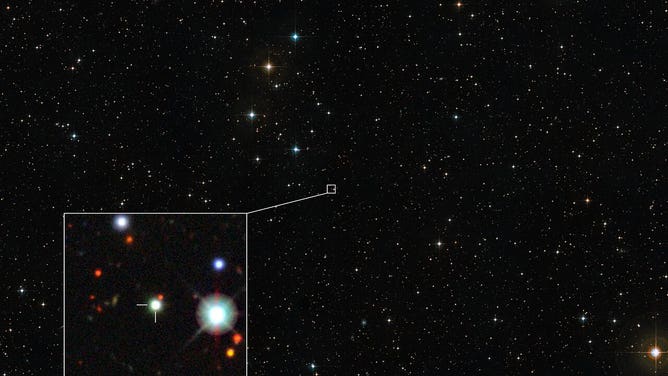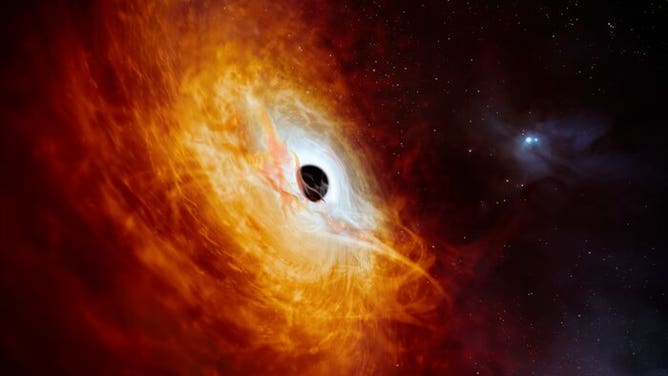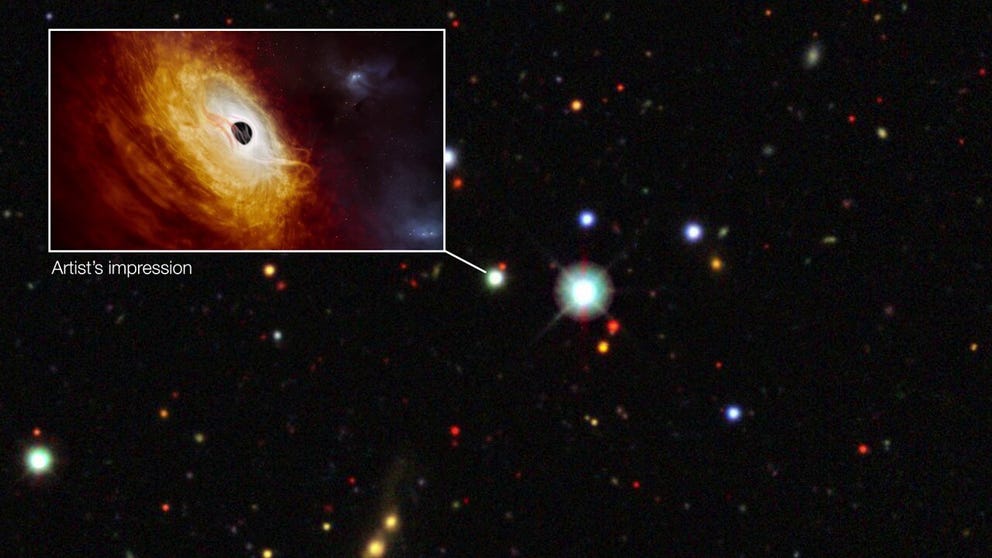Fastest-growing black hole gobbles up 1 sun a day to feed brightest object in universe
Quasars are the known as the brightest objects in the sky. Using the European Very Large Telescope astronomers say they have found the brightest one yet. “It has literally been staring us in the face until now," said astronomer Christopher Onken with Australian National University.
Journey the Milky Way to see the brightest known object in the Universe
This video takes us on a journey from our Milky Way far into the sky to the quasar J0529-4351, the bright core of a distant galaxy. The supermassive black hole powering J0529-4351 is the fastest-growing black hole ever discovered. The video ends with an artist’s impression of this record-breaking object. (Video credit: ESO/N. Risinger (skysurvey.org)/Digitized Sky Survey 2/Dark Energy Survey/M. Kornmesser. Music: Astral Electronic)
A hungry black hole feeding a record-breaking quasar provides the energy to emit enough light that astronomers say is the brightest object ever observed.
Astronomers used the European Southern Observatory’s Very Large Telescope (VLT) in Chile to observe a quasar known as J0529-4351 and published their findings in Nature Astronomy.
According to NASA, quasars are the extremely bright cores at the center of galaxies feeding off the energy consumed by supermassive black holes. The study authors say the black hole in the quasar is growing in mass by one sun a day, making it the fastest-growing black hole discovered yet.

This image shows the region of the sky in which the record-breaking quasar J0529-4351 is situated. Using ESO’s Very Large Telescope (VLT) in Chile, this quasar has been found to be the most luminous object known in the Universe to date. This picture was created from images forming part of the Digitized Sky Survey 2, while the inset shows the location of the quasar in an image from the Dark Energy Survey. (Credit: ESO/Digitized Sky Survey 2/Dark Energy Survey)
(ESO)
WHAT IS A BLACK HOLE? HERE'S WHY THESE ENIGMAS OF SPACE DON’T SUCK
"We have discovered the fastest-growing black hole known to date. It has a mass of 17 billion suns and eats just over a sun per day. This makes it the most luminous object in the known Universe," said study author Christian Wolf, an astronomer at the Australian National University.
How bright and how big?

This artist’s impression shows the record-breaking quasar J059-4351, the bright core of a distant galaxy that is powered by a supermassive black hole. Using ESO’s Very Large Telescope (VLT) in Chile, this quasar has been found to be the most luminous object known in the Universe to date. (Credit: ESO/M. Kornmesser)
Astronomers define huge astronomical objects compared to our solar system's Sun. The mass of a black hole is usually called a "solar mass." One solar mass is defined as the mass of our Sun.
Quasar J0529-435's supermassive black hole has a mass of 17 billion suns. The matter being pulled toward the black hole that forms a disc emits more than 500 trillion times more luminous energy than the Sun.
The hot accretion disc where all this matter is pulled measures seven light-years in diameter. Study co-author Samuel Lai, also with ANU, estimates it is the largest accretion disc in the Universe.
HUBBLE SPACE TELESCOPE USED TO WATCH BLACK HOLE EAT A STAR
Quasar J0529-435 is so far away that its light took more than 12 million light years to reach the telescope, according to the study.
Hunting for rare objects in the cosmos
There may be brighter and more massive quasars in the Universe. However, the study authors said that although quasars are the brightest objects in the Universe, the rarest and brightest are the hardest to find.
"Finding quasars requires precise observational data from large areas of the sky. The resulting datasets are so large, researchers often use machine-learning models to analyze them and tell quasars apart from other celestial objects," ESO said in a news release. "However, these models are trained on existing data, which limits the potential candidates to objects similar to those already known. If a new quasar is more luminous than any other previously observed, the program might reject it and classify it instead as a star not too distant from Earth."
This object was first discovered in 1980 during the ESO Schmidt Southern Sky Survey but wasn't identified as a quasar until recently.
An analysis of a European spacecraft observation of the object found it too bright, and astronomers believed it was a star. However, last year, on a second look using the Siding Spring Observatory in Australia, astronomers re-identified J0529-4351 as a distant quasar.
LISTEN TO THE HAUNTING SOUNDS OF A BLACK HOLE
"It is a surprise that it has remained unknown until today, when we already know about a million less impressive quasars. It has literally been staring us in the face until now," said co-author Christopher Onken, an astronomer at ANU.
Once astronomers realized it was a quasar, they brought in the big guns using ESO's Very Large Telescope to measure the object and determine its mass.
ESO said its 39-meter Extremely Large Telescope, currently under construction in Chile, will make identifying such luminous objects even more attainable.
